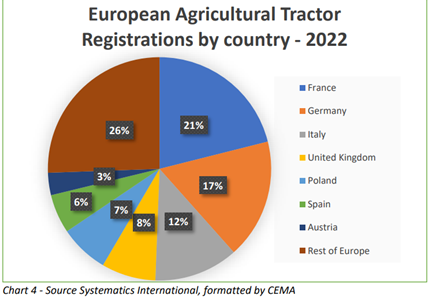The Future of UK Agricultural Equipment Market: A Path Towards Sustainability and Efficiency
Projected at a CAGR of around ~3.5% (2022-2027), the UK’s Agri equipment market grew during 2014-2018 but contracted sharply in 2019-2020 due to the COVID-19 pandemic.
STORY OUTLINE
- Precision agriculture tech, like GPS-guided tractors and drones, is set to revolutionize UK farming, enhancing efficiency through informed decisions on planting and irrigation.
- The UK’s net-zero commitment spurs demand for eco-friendly equipment. Electric tractors and soil-friendly machinery address environmental concerns and promote sustainable farming practices.
- Government incentives for sustainable practices and modern equipment are expected to boost market growth. Subsidies may lead to a 10% rise in equipment sales by 2025.
- Farmers unite for cost-effective solutions through machinery sharing. Community-driven ownership models not only save expenses but also foster a sense of unity among farmers.
| According to Ken Research, As the UK strives to achieve sustainable farming practices and address environmental concerns, the agricultural equipment market will continue to evolve, presenting both opportunities and challenges for farmers, manufacturers, and policymakers alike. Staying informed about these trends will be essential for stakeholders to navigate the evolving landscape successfully. |
The United Kingdom’s agricultural landscape is evolving rapidly, driven by technological advancements, environmental concerns, and shifting consumer preferences. The agricultural equipment market, a crucial component of this evolution, is witnessing transformative changes that are set to shape the future of farming in the UK. This article explores key trends and statistics that provide insights into the future of the UK agricultural equipment market.
1. Technological Advancements for Precision Agriculture
 For more information, request a free sample Report
For more information, request a free sample Report
Precision agriculture technologies are poised to become integral to the UK farming sector’s future. According to recent industry reports, the adoption of precision farming tools is projected to increase by over 20% annually.
These technologies, including GPS-guided tractors, sensor-equipped drones, and data analytics platforms, enable farmers to optimize their operations by making informed decisions about planting, irrigation, and fertilization.
2. Sustainability as a Driving Force

Visit A link Request for Custom Report
Sustainability is a key driver of change in the agricultural equipment market. The UK government’s commitment to achieving net-zero carbon emissions by 2050 has catalyzed efforts to develop eco-friendly farming practices.
Consequently, there is a growing demand for agricultural equipment that reduces environmental impact. Farm machinery manufacturers are investing in the production of electric and hybrid tractors, autonomous machinery, and equipment that minimizes soil compaction and chemical use.
3. Government Initiatives and Policies
Government policies and initiatives are expected to play a pivotal role in shaping the future of the agricultural equipment market. Subsidies and grants that incentivize farmers to adopt sustainable practices and invest in modern machinery are likely to gain prominence.
These policies align with the UK’s focus on sustainable agriculture and may significantly impact market growth. Experts project that government support for agricultural technology adoption could lead to an overall 10% increase in equipment sales by 2025.
In Conclusion, the future of the UK agricultural equipment market is undergoing a transformation that is reshaping the way farmers approach their operations. The integration of precision agriculture technologies, emphasis on sustainability, and collaborative ownership models are poised to drive significant changes.
